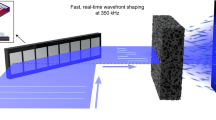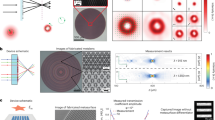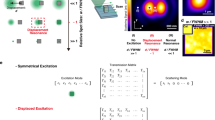Abstract
The manipulation of small objects with light has become an indispensable tool in many areas of research, ranging from physics to biology and medicine1,2,3,4,5,6,7. Here, we demonstrate how to implement micromanipulation at the optimal level of efficiency for arbitrarily shaped targets and inside complex environments such as disordered media. Our approach is to design wavefronts in the far field8,9,10,11,12,13,14,15 with optimal properties in the near field of the target to apply the strongest possible force, pressure or torque as well as to achieve the most efficient focus inside the target. This non-iterative technique only relies on a simple eigenvalue problem established from the system’s scattering matrix and its dependence on small shifts in specific target parameters (access to the near field of the target is not required). To illustrate this concept, we perform a proof-of-principle experiment in the microwave regime, fully confirming our predictions.
This is a preview of subscription content, access via your institution
Access options
Access Nature and 54 other Nature Portfolio journals
Get Nature+, our best-value online-access subscription
$29.99 / 30 days
cancel any time
Subscribe to this journal
Receive 12 print issues and online access
$209.00 per year
only $17.42 per issue
Buy this article
- Purchase on Springer Link
- Instant access to full article PDF
Prices may be subject to local taxes which are calculated during checkout



Similar content being viewed by others
Data availability
The data that support the plots within this paper and other findings of this study are available from the corresponding authors on reasonable request.
References
Ashkin, A., Dziedzic, J. M., Bjorkholm, J. E. & Chu, S. Observation of a single-beam gradient force optical trap for dielectric particles. Opt. Lett. 11, 288–290 (1986).
Thalhammer, G., Steiger, R., Bernet, S. & Ritsch-Marte, M. Optical macro-tweezers: trapping of highly motile micro-organisms. J. Opt. 13, 044024 (2011).
Bowman, R. et al. Position clamping in a holographic counterpropagating optical trap. Opt. Express 19, 9908–9914 (2011).
Jannasch, A., Mahamdeh, M. & Schäffer, E. Inertial effects of a small Brownian particle cause a colored power spectral density of thermal noise. Phys. Rev. Lett. 107, 228301 (2011).
Palima, D. & Glückstad, J. Gearing up for optical microrobotics: micromanipulation and actuation of synthetic microstructures by optical forces. Laser Photon. Rev. 7, 478–494 (2013).
Kheifets, S., Simha, A., Melin, K., Li, T. & Raizen, M. G. Observation of Brownian motion in liquids at short times: instantaneous velocity and memory loss. Science 343, 1493–1496 (2014).
Li, T. in Fundamental Tests of Physics with Optically Trapped Microspheres 81–110 (Springer, 2013).
Vellekoop, I. M. & Mosk, A. P. Focusing coherent light through opaque strongly scattering media. Opt. Lett. 32, 2309–2311 (2007).
van Putten, E. G. et al. Scattering lens resolves sub-100 nm structures with visible light. Phys. Rev. Lett. 106, 193905 (2011).
Xu, X., Liu, H. & Wang, L. V. Time-reversed ultrasonically encoded optical focusing into scattering media. Nat. Photon. 5, 154–157 (2011).
Dholakia, K. & Čižmár, T. Shaping the future of manipulation. Nat. Photon. 5, 335–342 (2011).
Mosk, A. P., Lagendijk, A., Lerosey, G. & Fink, M. Controlling waves in space and time for imaging and focusing in complex media. Nat. Photon. 6, 283–292 (2012).
Judkewitz, B., Wang, Y. M., Horstmeyer, R., Mathy, A. & Yang, C. Speckle-scale focusing in the diffusive regime with time reversal of variance-encoded light (TROVE). Nat. Photon. 7, 300–305 (2013).
Horstmeyer, R., Ruan, H. & Yang, C. Guidestar-assisted wavefront-shaping methods for focusing light into biological tissue. Nat. Photon. 9, 563–571 (2015).
Rotter, S. & Gigan, S. Light fields in complex media: mesoscopic scattering meets wave control. Rev. Mod. Phys. 89, 015005 (2017).
Čižmár, T., Mazilu, M. & Dholakia, K. In situ wavefront correction and its application to micromanipulation. Nat. Photon. 4, 388–394 (2010).
Polin, M., Ladavac, K., Lee, S.-H., Roichman, Y. & Grier, D. G. Optimized holographic optical traps. Opt. Express 13, 5831–5845 (2005).
Taylor, M. A., Waleed, M., Stilgoe, A. B., Rubinsztein-Dunlop, H. & Bowen, W. P. Enhanced optical trapping via structured scattering. Nat. Photon. 9, 669–673 (2015).
Lee, Y. E., Miller, O. D., Homer Reid, M. T., Johnson, S. G. & Fang, N. X. Computational inverse design of non-intuitive illumination patterns to maximize optical force or torque. Opt. Express 25, 6757–6766 (2017).
Mazilu, M., Baumgartl, J., Kosmeier, S. & Dholakia, K. Optical Eigenmodes; exploiting the quadratic nature of the energy flux and of scattering interactions. Opt. Express 19, 933–945 (2011).
Fernandez-Corbaton, I. & Rockstuhl, C. Unified theory to describe and engineer conservation laws in light-matter interactions. Phys. Rev. A 95, 053829 (2017).
Liu, Y. et al. Optimal nanoparticle forces, torques, and illumination fields. ACS Photon. 6, 395–402 (2019).
Taylor, M. A. Optimizing phase to enhance optical trap stiffness. Sci. Rep. 7, 555 (2017).
Wigner, E. P. Lower limit for the energy derivative of the scattering phase shift. Phys. Rev. 98, 145–147 (1955).
Smith, F. T. Lifetime matrix in collision theory. Phys. Rev. 118, 349–356 (1960).
Fan, S. & Kahn, J. M. Principal modes in multimode waveguides. Opt. Lett. 30, 135–137 (2005).
Winful, H. G. Delay time and the Hartman effect in quantum tunneling. Phys. Rev. Lett. 91, 260401 (2003).
Rotter, S., Ambichl, P. & Libisch, F. Generating particlelike scattering states in wave transport. Phys. Rev. Lett. 106, 120602 (2011).
Carpenter, J., Eggleton, B. J. & Schröder, J. Observation of Eisenbud–Wigner–Smith states as principal modes in multimode fibre. Nat. Photon. 9, 751–757 (2015).
Xiong, W. et al. Spatiotemporal control of light transmission through a multimode fiber with strong mode coupling. Phys. Rev. Lett. 117, 053901 (2016).
Gérardin, B. et al. Particlelike wave packets in complex scattering systems. Phys. Rev. B 94, 014209 (2016).
Böhm, J., Brandstötter, A., Ambichl, P., Rotter, S. & Kuhl, U. In situ realization of particlelike scattering states in a microwave cavity. Phys. Rev. A 97, 021801 (2018).
Brandstötter, A., Girschik, A. & Ambichl, P. & Rotter, S. Shaping the branched flow of light through disordered media. Proc. Natl Acad. Sci. USA 116, 13260–13265 (2019).
Ambichl, P. et al. Focusing inside disordered media with the generalized Wigner-Smith operator. Phys. Rev. Lett. 119, 033903 (2017).
Fyodorov, Y. V. & Sommers, H.-J. Statistics of resonance poles, phase shifts and time delays in quantum chaotic scattering: Random matrix approach for systems with broken time-reversal invariance. J. Math. Phys. 38, 1918–1981 (1997).
Brandbyge, M. & Tsukada, M. Local density of states from transmission amplitudes in multichannel systems. Phys. Rev. B 57, R15088–R15091 (1998).
Davy, M., Shi, Z., Wang, J., Cheng, X. & Genack, A. Z. Transmission eigenchannels and the densities of states of random media. Phys. Rev. Lett. 114, 033901 (2015).
Cheng, X. & Genack, A. Z. Focusing and energy deposition inside random media. Opt. Lett. 39, 6324–6327 (2014).
Zhou, E. H., Ruan, H., Yang, C. & Judkewitz, B. Focusing on moving targets through scattering samples. Optica 1, 227–232 (2014).
Ma, C., Xu, X., Liu, Y. & Wang, L. V. Time-reversed adapted-perturbation (TRAP) optical focusing onto dynamic objects inside scattering media. Nat. Photon. 8, 931–936 (2014).
Bechinger, C. et al. Active particles in complex and crowded environments. Rev. Mod. Phys. 88, 045006 (2016).
Drémeau, A. et al. Reference-less measurement of the transmission matrix of a highly scattering material using a DMD and phase retrieval techniques. Opt. Express 23, 11898–11911 (2015).
Kotar, J. et al. Optimal hydrodynamic synchronization of colloidal rotors. Phys. Rev. Lett. 111, 228103 (2013).
Ruan, H. et al. Focusing light inside scattering media with magnetic-particle-guided wavefront shaping. Optica 4, 1337–1343 (2017).
Acknowledgements
We thank P. Ambichl, N. Bachelard, H. Cao, S. Gigan, J. Hüpfl, F. Libisch, O. D. Miller and D. B. Phillips for stimulating discussions, and L. Kogler for helpful advice on NGSolve. The simulations were carried out in part on the Vienna Scientific Cluster (VSC). M.K., A.B., K.P. and S.R. were partly supported by the European Commission under project NHQWAVE No. MSCA-RISE 691209 and by the Austrian Science Fund (FWF) under project number P32300 (WAVELAND). A.B. is the recipient of a DOC fellowship of the Austrian Academy of Sciences at the Institute for Theoretical Physics of the Vienna University of Technology (TU Wien). The experiments were carried out in Nice during a long-term visit of K.P. and were supported by the European Commission’s H2020 programme through the Open Future Emerging Technology Project ‘NEMF21’ (664828).
Author information
Authors and Affiliations
Contributions
The theoretical and numerical analysis was carried out by M.H., M.K. and A.B. under the supervision of S.R., whereas Y.V.F. contributed to the derivation of equation (2). Measurements and data evaluation were carried out by K.P. under the supervision of U.K. M.H. and S.R. wrote the manuscript with input from all authors.
Corresponding authors
Ethics declarations
Competing interests
The authors declare no competing interests.
Additional information
Publisher’s note Springer Nature remains neutral with regard to jurisdictional claims in published maps and institutional affiliations.
Supplementary information
Supplementary Information
Supplementary Figs. 1–6 and discussion.
Rights and permissions
About this article
Cite this article
Horodynski, M., Kühmayer, M., Brandstötter, A. et al. Optimal wave fields for micromanipulation in complex scattering environments. Nat. Photonics 14, 149–153 (2020). https://doi.org/10.1038/s41566-019-0550-z
Received:
Accepted:
Published:
Issue Date:
DOI: https://doi.org/10.1038/s41566-019-0550-z
This article is cited by
-
Depth-targeted energy delivery deep inside scattering media
Nature Physics (2022)
-
Shaping the propagation of light in complex media
Nature Physics (2022)
-
Anti-reflection structure for perfect transmission through complex media
Nature (2022)
-
Compressively sampling the optical transmission matrix of a multimode fibre
Light: Science & Applications (2021)
-
Maximum information states for coherent scattering measurements
Nature Physics (2021)



